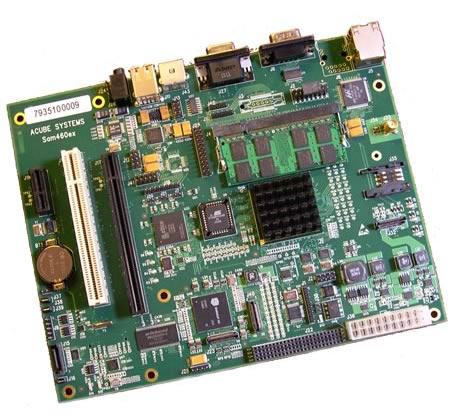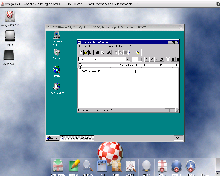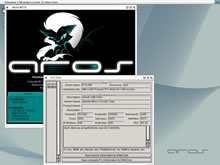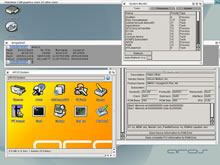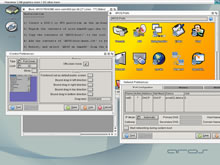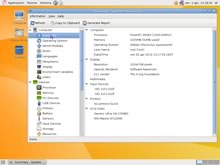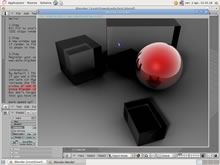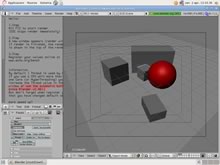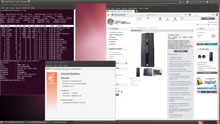Sam460ex is a PowerPC modular motherboard engineered
and produced by ACube Systems and it is totally made in Italy.
The core of the board is the PowerPC 460EX, a System On Chip (SoC)
from Applied Micro which allowed us to build a PowerPC motherboard
running at 1.166 Ghz, scalable for different uses and still fanless
and very low power consumption!
The Sam460ex supports 3 expansion slots: PCI, PCIe 1x and PCIe 4x.
Also it has onboard audio and video chips as well as a SATA2 port.
While this board is the fastest of our products, we also wanted to
add more features to it. You can have the following on your Sam460:
- UMTS/GSM module
- NAND Flash
- 7 USB ports
- Gigabit ethernet
- 5 boot medias
- and more...
- flex-ATX form factor (21.6 x 17 cm)
- 8 layers PCB
- AMCC 460ex SoC – upto 1.1150 Ghz
- max 2 GB DDR2 Ram – 200-pin SODIMM
- Silicon Motion SM502 embedded MoC (audio/video)
max 64Mb gfx Ram
- Audio 5.1 Realtek ALC655 codec
- PCI-express 4x lanes slot (16x mechanical connector)
- PCI-express 1x lane slot (* check notes)
- PCI slot, 32 bit, 66/33 Mhz, 3.3V
- 1x SATA2 port (* check notes)
- 6x USB2 EHCI/OHCI ports + 1 USB1.1 port
- 1x GigaEthernet port (another Giga Ethernet port
optional)
- Lattice XP2 FPGA with 80 I/O pins expansion connector
(optional)
- UMTS/GSM module (optional requires add-on card)
- 512 MB NAND Flash (optional)
- integrated SD USB card reader
- RTC clock
- Serial port, 8-wires
- I2C and SPI/I2C buses
- passive cooling (only on low speed CPUs)
- U-Boot 2010.06
Notes: the SATA2 port and the PCI-e 1x slot are mutually
exclusive, only one of them can be used at a time
Please visit our online shop for a list of Sam460ex complete systems here
The board will NOT replace the Sam440ex-flex board.
For information please write to:
| DRIVER
& SOFTWARE DOWNLOAD |
Please visit the official ACube Systems website to download latest firmware, drivers and software updates here
|
| Sam460ex
Revision 1 - production board |
|
| FREQUENTLY ASKED QUESTIONS |
How to obtain the maximum performance from my Sam460ex ?
Keep your firmware updated, the latest version for your board may be found HERE
Under AmigaOS4 always keep your system updated.
Use the following utility to tweeck some 440ep settings: Sam460ex_setup
I'm an AmigaOS4 developer, how to obtain the best performance?
When possible use DMA accelerated functions to transfer data from RAM to video RAM, or from RAM to RAM.
Starting from rtg.library V41.4347 WritePixelArray and ReadPixelArrays (and other functions) are DMA accelerated if the pixel format is >= 15 bits. Where possible, anyway avoid using ReadPixelArray since reading from video RAM is always very slow, regardless if the video card is on the PCI or PCI Express bus. It's best to keep a copy of video data in main RAM and read from there instead.
If Write/ReadPixelArray aren't suitable for your application, you may try with CopyMem and CopyMemQuick with exec.library V53.29 and newer. In this case the data to be transfered must meet some requirements: the block must have size >= 64 KB, even, and aligned to 4 bytes, the source must be in main RAM, and the source and destination regions must not overlap. The performance is obtained if both source and destination were allocated with the MEMF_HWALIGNED flag.
Due the time required to setup the DMA controller, the minimal optimal block size may be bigger than 64 KB to obtain a trasfer rate higher than using the sole CPU.
To be taken in consideration that the DMA channel may be busy from a previous DMA operation too.
Since rtg.library and exec.library use two different DMA channels, it may be possible to interleave DMA transfers with rtg.library and exec.library to obtain the maximum bandwidth possible on the 460ex. Another alternative is to start a DMA transfer and then a CPU transfer if the two data blocks aren't correlated.
An important aspect to keep in consideration when optimizing applications for the 4x0 platform is to keep the data aligned to their natural size, otherwise the 4x0 will generate an exception for each data not aligned, slowing down execution. This is usually done via GCC specific options, for example -mstrict-align. |
